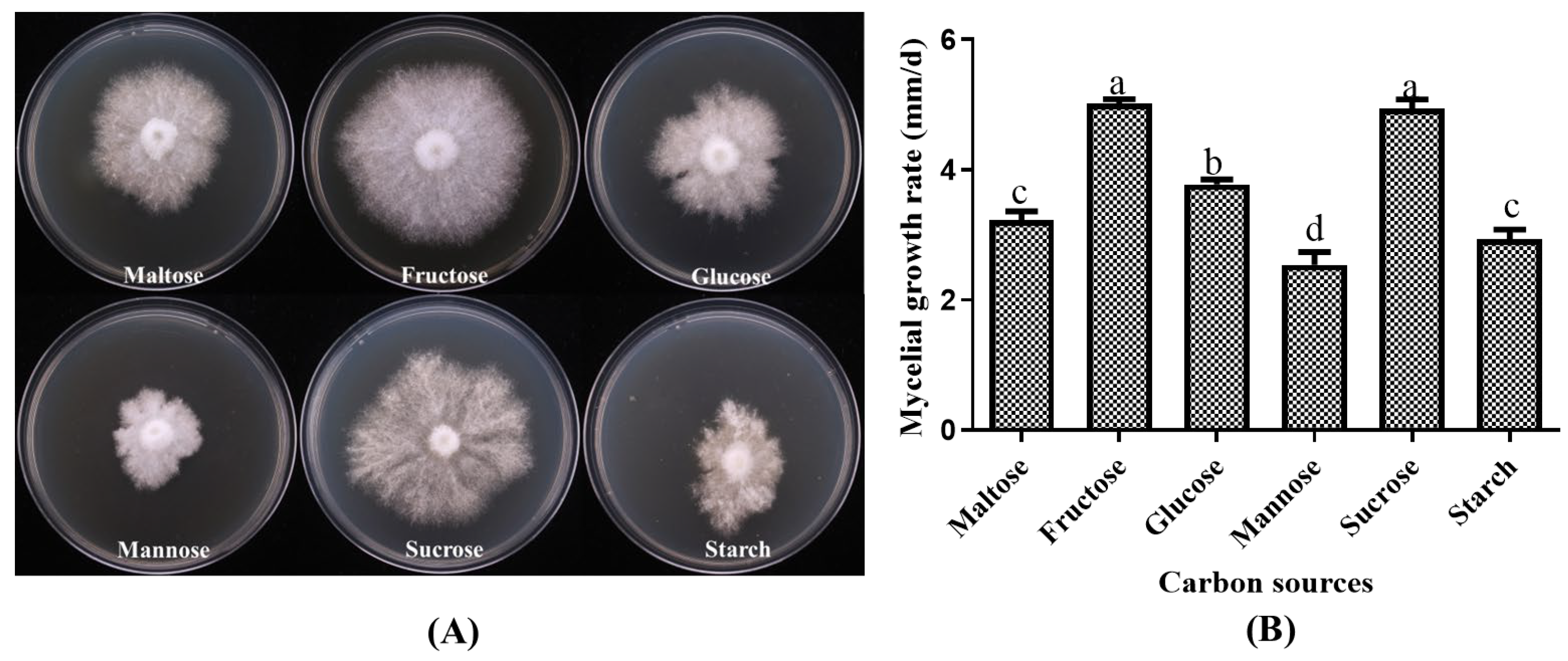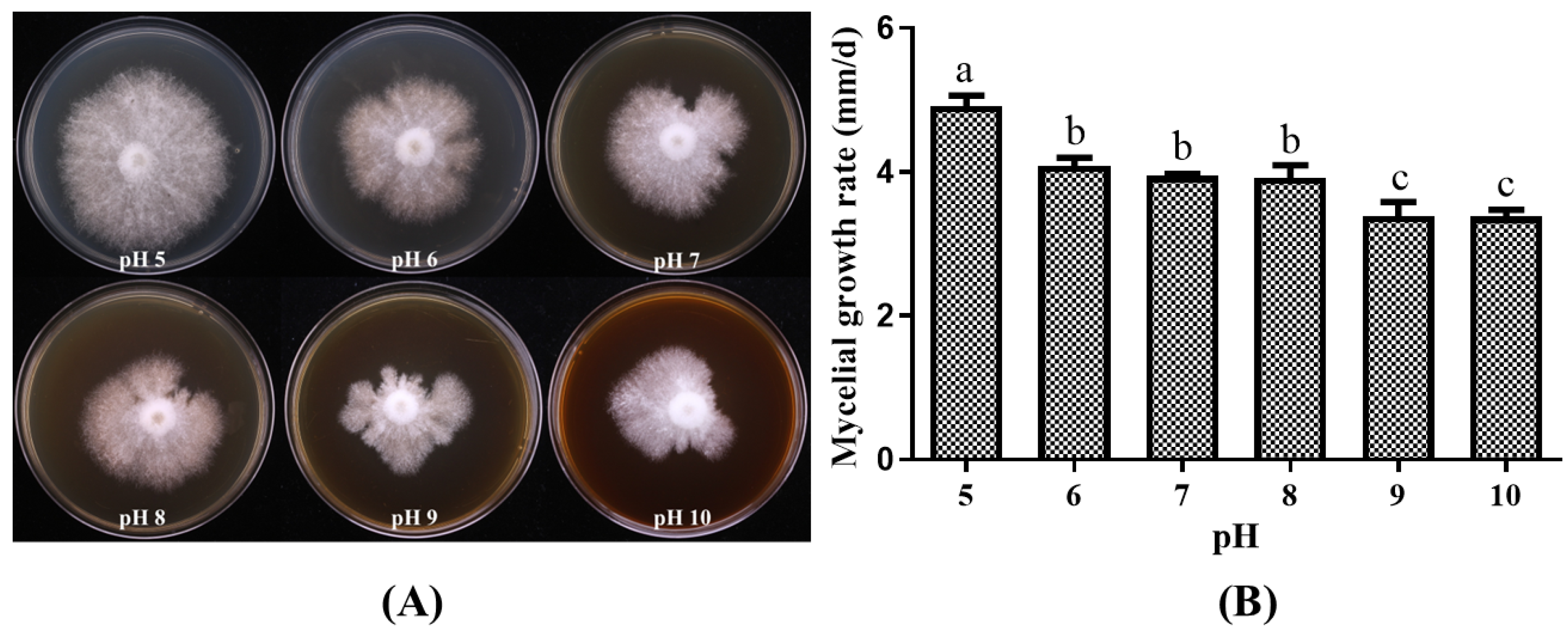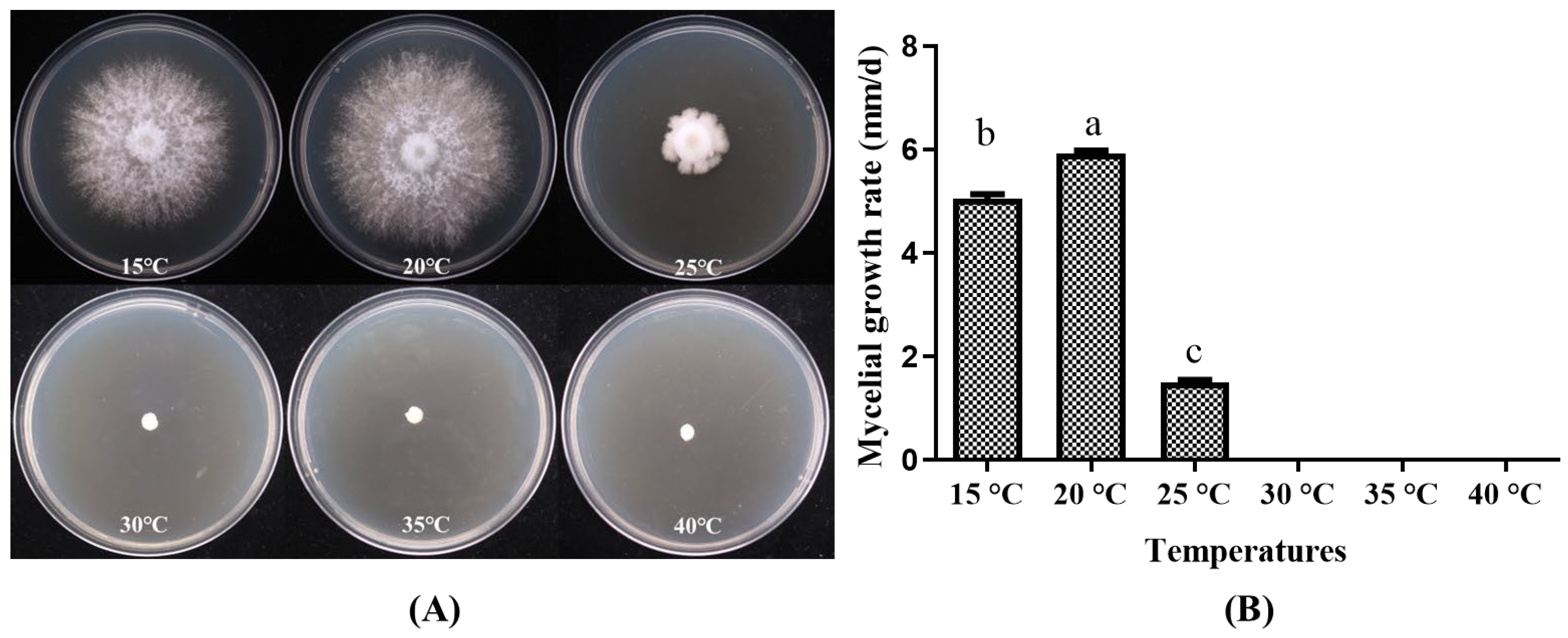Characteristics, Domestication and Nutrient Analysis of Wild Pleurotus placentodes
Abstract
1. Introduction
2. Materials and Methods
2.1. Experimental Materials
2.1.1. Wild Fruiting Bodies
2.1.2. Culture Medium
2.2. Experimental Methods
2.2.1. Identification of the Strain
2.2.2. Study on Growth Characteristics
2.2.3. Domestication Cultivation
2.2.4. Analysis of Nutritional Value Components
2.3. Statistical Analysis
2.4. Main Reagents
3. Results
3.1. Identification of Strain X21214
3.1.1. Morphological Identification of Strains
3.1.2. Molecular Identification of Strain X21214
3.2. Growth Characteristics Experiment
3.2.1. Growth of P. placentodes X21214 Mycelia on Different Carbon Sources
3.2.2. Growth of P. placentodes X21214 Mycelia on Different Nitrogen Sources
3.2.3. Growth of P. placentodes X21214 Mycelia on Different pH
3.2.4. Growth of P. placentodes X21214 Mycelium on Different Temperatures
3.3. Domestication Cultivation and Agronomic Traits of Fruiting Body
3.4. Analysis of Nutritional
3.4.1. Basic Nutrients
3.4.2. Amino Acid Composition Analysis
4. Conclusions and Discussion
Author Contributions
Funding
Institutional Review Board Statement
Informed Consent Statement
Data Availability Statement
Conflicts of Interest
References
- Rodrigues Barbosa, J.; dos Santos Freitas, M.M.; da Silva Martins, L.H.; de Carvalho, R.N.J. Polysaccharides of mushroom Pleurotus spp.: New extraction techniques, biological activities and development of new technologies. Carbohydr. Polym. 2020, 229, 115550. [Google Scholar] [CrossRef]
- Sharma, A.; Sharma, A.; Tripathi, A. Biological activities of Pleurotus spp. polysaccharides: A review. J. Food Biochem. 2021, 45, e13748. [Google Scholar] [CrossRef]
- Wang, Q.; Niu, L.L.; Liu, H.P.; Wu, Y.R.; Li, M.Y.; Jia, Q. Structural characterization of a novel polysaccharide from Pleurotus citrinopileatus and its antitumor activity on H22 tumor-bearing mice. Int. J. Biol. Macromol. 2021, 168, 251–260. [Google Scholar] [CrossRef] [PubMed]
- Shamim, M.Z.; Mishra, A.K.; Kausar, T.; Mahanta, S.; Sarma, B.; Kumar, V.; Mishra, P.K.; Panda, J.; Baek, K.H.; Mohanta, Y.K. Exploring edible mushrooms for diabetes: Unveiling their role in prevention and treatment. Molecules 2023, 28, 2837. [Google Scholar] [CrossRef] [PubMed]
- Berkeley, M.J. Decades of fungi, XXXVII, XXXVIII. Sikkim and Khassya fungi. Hooker’s J. Bot. Kew Gard. Misc. 1852, 4, 97–107. [Google Scholar]
- Liu, X.-B.; Horak, E.; Yang, Z.L.; Li, J. Pleurotus placentodes, originally described from Sikkim, rediscovered after 164 years. Phytotaxa 2016, 260, 183–190. [Google Scholar] [CrossRef]
- Huang, H.; Li, X.; Hu, X.; Sun, H.; Zhang, J.; Wu, X.; Fu, J. Biological Characteristics, Domestication and Cultivation of Wild Tyromyces kmetii. Horticulturae 2024, 10, 1177. [Google Scholar] [CrossRef]
- Li, Y.; Li, T.H.; Yang, Z.L.; Bau, T.; Dai, Y. Atlas of Chinese Macrofungal Resources; Hongyuan Farmers’ Publishing House: Zhengzhou, China, 2015. [Google Scholar]
- Huang, N. A Color Atlas of Large Fungi in China; China Agricultural Publishing House: Beijing, China, 1998. [Google Scholar]
- Jin, S.S.; Liu, X.; Hou, R.L.; Yu, Q.M.; Wang, D.T.; Hu, K.H.; Zheng, M.F.; Fu, J.S. Identification and biological activity of a medicinal Inonotus. J. Northwest A F Univ. (Nat. Sci. Ed.) 2018, 46, 130–139. [Google Scholar] [CrossRef]
- Hu, X.; Yang, R.J.; Wu, D.X.; Zhu, X.F.; Wu, X.P.; Fu, J.S. Antioxidant and anti-Huh7 hepatocarcinoma cell activities of polysaccharides from a strain of Trametes sanguinea. Mycosystema 2023, 42, 793–807. [Google Scholar] [CrossRef]
- Niu, Y.R.; Song, S.; Liu, Y.; Huang, Z.X.; Rong, C.B.; Zhao, S.; Wang, S.X. Biological characteristics and domestication of Pleurotus placentodes. Acta Edulis Fungi 2017, 24, 99. [Google Scholar] [CrossRef]
- Wang, H.J.; Li, G.J.; Zhao, R.L. Artificial cultivation and nutrition analysis of Pleurotus placentodes wild strain. Mycosystema 2018, 37, 606–616. [Google Scholar] [CrossRef]
- AOAC International. Official Methods of Analysis of AOAC International, 18th ed.; AOAC Int.: Gaithersburg, MD, USA, 2010; Volume 6, pp. 90022–90025. Available online: https://pubmed.ncbi.nlm.nih.gov/12374420 (accessed on 7 June 2025).
- Jin, Y.H.; Deng, C.J.; Zhao, H.; Yang, W.; Nie, Y.Y.; Li, B. Analytical determination on nutrients and purine contents of three common edible mushrooms. Edible Fungi China 2018, 37, 62–65+81. [Google Scholar] [CrossRef]
- Lu, X.; Zheng, Q.X.; Ye, L.Y.; Ding, Z.Q.; Chu, Y.R.; Huang, Q.X.; Wu, X.P. Identification and biological characteristics analysis of a wild Pleurotus pulmonarius. Genom. Appl. Biol. 2017, 36, 1997–2004. [Google Scholar] [CrossRef]
- Leif, T.; Maria, V. Chaenothecopsis in a molecular phylogeny based on nuclear rDNA ITS and LSU sequences. Mol. Phylogenetics 2005, 5, 427–442. [Google Scholar] [CrossRef]
- Schoch, C.L.; Seifert, K.A.; Huhndorf, S.; Robert, V.; Spouge, J.L.; Levesque, C.A.; Chen, W.; Fungal Barcoding Consortium; Bolchacova, E.; Voigt, K.; et al. Nuclear ribosomal internal transcribed spacer (ITS) region as a universal DNA barcode marker for Fungi. Proc. Natl. Acad. Sci. USA 2012, 109, 6241–6246. [Google Scholar] [CrossRef]
- Snajdr, J.; Baldrian, P. Temperature affects the production, activity and stability of Ligninolytic enzymes in Pleurotus ostreatus and Trametes versicolor. Folia Microbiol. 2007, 52, 498–502. [Google Scholar] [CrossRef]
- De, A.; Mridha, D.; Roychowdhury, T.; Bidyut, B.; Anindya, S. Substrate level optimization for better yield of oyster mushroom (Pleurotus ostreatus) production, using different ratio of rice straw and sugarcane bagasse. World J. Microbiol. Biotechnol. 2023, 39, 270. [Google Scholar] [CrossRef]
- Reis, F.S.; Barros, L.; Martins, A.; Ferreira, I.C.F.R. Chemical composition and nutritional value of the most widely appreciated cultivated mushrooms: An inter-species comparative study. Food Chem. Toxicol. 2012, 50, 191–197. [Google Scholar] [CrossRef]
- Wen, C.Y.; Xu, M.; Yang, Y.L.; Zhang, J.; Nie, K.; Zhang, J. Research progress on nutritional composition and value evaluation of wild edible mushrooms in China. Edible Fungi China 2021, 40, 1–10. [Google Scholar] [CrossRef]
- Krause, N.; Wegner, A. N-acetyl-aspartate metabolism at the interface of cancer, immunity, and neurodegeneration. Curr. Opin. Biotechnol. 2024, 85, 103051. [Google Scholar] [CrossRef]
- Kim, H.Y.; Huang, B.X.; Spector, A.A. Phosphatidylserine in the brain: Metabolism and function. Prog. Lipid Res. 2014, 56, 1–18. [Google Scholar] [CrossRef] [PubMed]
- de Paz-Lugo, P.; Lupianez, J.A.; Sicilia, J.; Melendez-Hevia, E. Control analysis of collagen synthesis by glycine, proline and lysine in bovine chondrocytes in vitro: Its relevance for medicine and nutrition. Biosystems 2023, 232, 105004. [Google Scholar] [CrossRef] [PubMed]
- Zhang, X.; Kapoor, D.; Jeong, S.J.; Fappi, A.; Stitham, J.; Shabrish, V.; Sergin, I.; Yousif, E.; Rodriguez-Velez, A.; Yeh, Y.S.; et al. Identification of a leucine-mediated threshold effect governing macrophage mTOR signalling and cardiovascular risk. Nat. Metab. 2024, 6, 359–377. [Google Scholar] [CrossRef] [PubMed]
- Cane, S.; Geiger, R.; Bronte, V. The roles of arginases and arginine in immunity. Nat. Rev. Immunol. 2025, 25, 266–284. [Google Scholar] [CrossRef]
- Elango, R. Methionine nutrition and metabolism: Insights from animal studies to inform human nutrition. J. Nutr. 2020, 150, 2518S–2523S. [Google Scholar] [CrossRef]
- Mao, X.; Zeng, X.; Qiao, S.; Wu, G.; Li, D. Specific roles of threonine in intestinal mucosal integrity and barrier function. Front. Biosci. (Elite Ed.) 2011, 3, 1192–1200. [Google Scholar] [CrossRef]
- Saurav, S.; Tanwar, J.; Ahuja, K.; Motiani, R.K. Dysregulation of host cell calcium signaling during viral infections: Emerging paradigm with high clinical relevance. Mol. Aspects Med. 2021, 81, 101004. [Google Scholar] [CrossRef]
- Huang, X.; Zhao, J.V. The associations of genetically predicted plasma alanine with coronary artery disease and its risk factors: A mendelian randomization study. Am. J. Clin. Nutr. 2023, 118, 1020–1028. [Google Scholar] [CrossRef]
- Odigbo, C.; Adenipekun, C.; Oladosu, I.; Ogunjobi, A. Polyethylene terephthalate (PET) biodegradation by Pleurotus ostreatus and Pleurotus pulmonarius. Environ. Monit. Assess. 2023, 195, 585. [Google Scholar] [CrossRef]
- Sun, L.; Yin, X.; Sossah, F.L.; Han, X.; Li, Y. Comparative genomic analysis of Pleurotus species reveals insights into the evolution and coniferous utilization of Pleurotus placentodes. Front. Mol. Biosci. 2023, 10, 1292556. [Google Scholar] [CrossRef]
- Yin, Z.H.; Liu, X.P.; Wang, J.M.; Xi, X.F.; Zhang, Y.; Zhao, R.L.; Kang, W.Y. Structural characterization and anticoagulant activity of a 3-O-methylated heteroglycan from fruiting bodies of Pleurotus placentodes. Front. Chem. 2022, 10, 825127. [Google Scholar] [CrossRef]
- Liu, X.Q.; Shao, W.J.; Liu, X.P.; Zhang, Y.; Liu, H.; Wang, J.M.; Ma, C. Protective effects of Pleurotus placentodes against liver injury in mice via the PTGS2, NR3C1 and PPARA signaling pathways. J. Funct. Foods 2024, 122, 106459. [Google Scholar] [CrossRef]







| Strain Name | Full Bag Time (d) | Primordium Occurrence Time (d) | Harvest Time (d) | Average Fresh Weight per Flower (g) | Whether There Is a Second Tide |
|---|---|---|---|---|---|
| P. placentodes | 23 | 10 | 7 | 39.40 | Yes |
| Nutrient Content | Content (g/100 g) | |||
|---|---|---|---|---|
| P. placentodes | P. eryngii [15] | F. velutipes [15] | P. ostreatus [15] | |
| Moisture (g/100 g) (fresh) | 91.45 | 90.26 | 89.32 | 90.89 |
| Moisture (g/100 g) (dry) | 16.0 | 4.62 | 4.45 | 6.75 |
| Ash (g/100 g) | 6.5 | 4.90 | 7.23 | 9.47 |
| Fat (g/100 g) | 1.0 | 5.13 | 5.51 | 5.54 |
| Protein (g/100 g) | 30.30 | 16.39 | 20.64 | 21.24 |
| Soluble sugar (g/100 g) | 6.60 | 1.50 | 1.50 | 4.72 |
| Dietary fiber (g/100 g) | 29.2 | 34.03 | 37.27 | 41.85 |
| Na (mg/100 g) | 8.77 | - | - | - |
| Amino Acid Composition | Content (g/100 g) | |||
|---|---|---|---|---|
| P. placentodes | P. eryngii [15] | F. velutipes [15] | P. ostreatus [15] | |
| Asp | 2.15 | 1.83 | 1.58 | 1.41 |
| Glu | 4.49 | 2.95 | 4.41 | 5.90 |
| Ser | 1.21 | 0.71 | 0.66 | 0.55 |
| His * | 0.47 | 0.50 | 0.60 | 0.47 |
| Gly | 1.02 | 0.97 | 0.94 | 0.80 |
| Thr * | 1.15 | 0.82 | 0.77 | 0.70 |
| Arg | 1.48 | 1.14 | 0.85 | 0.68 |
| Ala | 1.52 | 1.25 | 1.21 | 1.23 |
| Tyr | 0.58 | 0.44 | 0.63 | 0.08 |
| Cys | - | 0.06 | 0.05 | 0.05 |
| Val * | 1.23 | 1.57 | 1.54 | 1.24 |
| Met * | 0.75 | 0.23 | 0.21 | 0.17 |
| Phe * | 0.93 | 0.72 | 1.01 | 0.57 |
| Ile * | 0.7 | 0.83 | 0.76 | 0.62 |
| Leu * | 1.39 | 1.19 | 1.14 | 0.91 |
| Lys * | 1.34 | 1.11 | 1.20 | 0.70 |
| Pro | 1.05 | 0.29 | 0.27 | 0.32 |
| Total amino acids (TAA) | 21.5 | 16.59 | 17.82 | 16.38 |
| Essential amino acids (EAA) | 7.96 | 6.97 | 7.23 | 5.38 |
| Non-essential amino acids (NEAA) | 13.54 | 9.62 | 10.59 | 11.0 |
| EAA/TAA | 0.37 | 0.42 | 0.41 | 0.33 |
| EAA/NEAA | 0.59 | 0.72 | 0.68 | 0.49 |
Disclaimer/Publisher’s Note: The statements, opinions and data contained in all publications are solely those of the individual author(s) and contributor(s) and not of MDPI and/or the editor(s). MDPI and/or the editor(s) disclaim responsibility for any injury to people or property resulting from any ideas, methods, instructions or products referred to in the content. |
© 2025 by the authors. Licensee MDPI, Basel, Switzerland. This article is an open access article distributed under the terms and conditions of the Creative Commons Attribution (CC BY) license (https://creativecommons.org/licenses/by/4.0/).
Share and Cite
Cai, L.; Li, X.; Hu, X.; Zhang, J.; Sun, H.; Gao, L.; Fu, J. Characteristics, Domestication and Nutrient Analysis of Wild Pleurotus placentodes. Foods 2025, 14, 3975. https://doi.org/10.3390/foods14223975
Cai L, Li X, Hu X, Zhang J, Sun H, Gao L, Fu J. Characteristics, Domestication and Nutrient Analysis of Wild Pleurotus placentodes. Foods. 2025; 14(22):3975. https://doi.org/10.3390/foods14223975
Chicago/Turabian StyleCai, Linna, Xiaomin Li, Xin Hu, Junli Zhang, Huijuan Sun, Lei Gao, and Junsheng Fu. 2025. "Characteristics, Domestication and Nutrient Analysis of Wild Pleurotus placentodes" Foods 14, no. 22: 3975. https://doi.org/10.3390/foods14223975
APA StyleCai, L., Li, X., Hu, X., Zhang, J., Sun, H., Gao, L., & Fu, J. (2025). Characteristics, Domestication and Nutrient Analysis of Wild Pleurotus placentodes. Foods, 14(22), 3975. https://doi.org/10.3390/foods14223975






